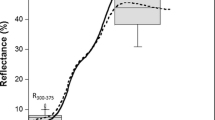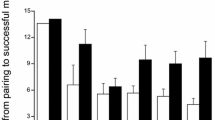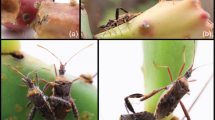Abstract
The physiological mechanism underlying resource allocation in sexual selection studies has been little studied. One candidate is hormones as these favor resource allocation to reproductive traits but impair survival due to a resource over-expenditure directed to the former traits. We have investigated whether a juvenile hormone analog (JHa, methoprene) administrated topically is involved in the resource allocation to wing pigmentation (an ornamental trait), fat reserves and flight muscle mass in both sexes of Calopteryx haemorrhoidalis and C. virgo. We also investigated the possible negative effect of such implementation on abdomen mass (an indirect measure of egg production) and field-based survival in adult males of C. haemorrhoidalis and C. splendens. We found that males and females treated with JHa, against a control group, developed higher wing pigmentation and showed reduced fat reserves but had no change in muscle mass. In females, JHa decreased abdominal weight (an indicator of fecundity) and in males, survival was impaired only in C. splendens. These results support the idea that JH induces resource allocation to wing pigmentation, a sexually selected trait in both sexes. Thus, this study suggests that the action of JH could be a mechanistic link between ornaments and physiological condition in both males and females.


Similar content being viewed by others
References
Anderson DR, Link WA, Johnson DH et al (2001) Suggestions for presenting the results of data analyses. J Wildl Manage 65:373–378
Andersson M (1994) Sexual selection. Princeton University Press, Princeton
Andersson M, Simmons LW (2006) Sexual selection and mate choice. Trends Ecol Evol 21:296–302
Burnham KP, Anderson DR (1998) Model selection and inference. A practical information-theoretic approach. Springer, Berlin
Carranza J (2009) Defining sexual selection as sex-dependent selection. Anim Behav 77:749–751
Chapman RF (1998) The insects. Structure and function. Cambridge University Press, Cambridge
Clutton-Brock TH (1983) The cost of reproduction to red deer hinds. J Anim Ecol 52:367–384
Clutton-Brock T (2007) Sexual selection in males and females. Science 318:1882–1885
Clutton-Brock T (2009) Sexual selection in females. Anim Behav 77:3–11
Contreras-Garduño J, Canales-Lazcano J, Córdoba-Aguilar A (2006) Wing pigmentation, immune ability and fat reserves in males of the rubyspot damselfly Hetaerina americana. J Ethol 24:165–173
Contreras-Garduño J, Lanz-Mendoza H, Córdoba-Aguilar A (2007) The expression of a sexually selected trait correlates with different immune defense components and survival in males of the American rubyspot. J Insect Physiol 53:612–621
Contreras-Garduño J, Córdoba-Aguilar A, Lanz-Mendoza H et al (2009a) Territorial behaviour and immunity are mediated by juvenile hormone: the physiological basis of honest signaling? Funct Ecol 23:159–163
Contreras-Garduño J, Canales-Lazcano J, Jiménez-Cortés JG et al (2009b) Spatial and temporal population differences in male density and condition in the American rubyspot, Hetaerina americana (Insecta: Calopterygidae). Ecol Res 24:21–29
Corbet P (1999) Dragonflies: behaviour and ecology of Odonata. Harley Books, Essex
Cordero A (1999) Forced copulations and female contact guarding at a high male density in a calopterygid damselfly. J Insect Behav 12:27–37
Córdoba-Aguilar A (2002) Wing pigmentation in territorial male damselflies, Calopteryx haemorrhoidalis: a possible relation to sexual selection. Anim Behav 63:759–766
Córdoba-Aguilar A, Cordero Rivera A (2005) Evolution and ecology of Calopterygidae (Zygoptera: Odonata): Status of knowledge and research perspectives. Neotrop Entomol 34:861–879
Córdoba-Aguilar A, Salamanca-Ocaña JC, Lopezaraiza M (2003) Female reproductive decisions and parasite burden in a calopterygid damselfly (Insecta: Odonata). Anim Behav 66:81–87
Darwin C (1871) The descent of man and selection in relation to sex. John Murray, London
Dubrovsky EB, Dubrovskaya VA, Berger EM (2002) Juvenile hormone signaling during oogenesis in Drosophila melanogaster. Insect Bioch Mol Biol 32:1555–1565
Elekonich MM, Jez K, Ross AJ et al (2003) Larval juvenile hormone treatment affects pre-adult development, but not adult age at onset of foraging in worker honey bees (Apis mellifera). J Insect Physiol 49:359–366
Emlen DJ, Nijhout HF (1999) Hormonal control of male horn length dimorphism in the horned beetle Onthophagus taurus. J Insect Physiol 45:45–53
Emlen DJ, Nijhout HF (2001) Hormonal control of male horn length dimorphism in Onthophagus taurus (Coleoptera: Scarabaeidae): a second critical period of sensitivity to juvenile hormone. J Insect Physiol 47:1045–1054
Flatt T, Kawecki TJ (2007) Juvenile hormone as a regulator of the trade-off between reproduction and life span in Drosophila melanogaster. Evolution 61:1980–1991
Flatt T, Tu MP, Tatar M (2005) Hormonal pleiotropy and the juvenile hormone regulation of Drosophila development and life history. Bioessays 27:999–1010
Flatt T, Heyland A, Rus F et al (2008) Hormonal regulation of the humoral innate immune response in Drosophila melanogaster. J Exp Biol 211:2712–2724
Fry CL (2006) Juvenile hormone mediates a trade-off between primary and secondary sexual traits in stalk-eyed flies. Evol Develop 8:191–201
Gadenne C (1993) Effects of fenoxycarb, juvenile hormone mimetic, on female sexual behaviour of the black cutworm, Agrotis ipsilon (Lepidoptera: noctuidae). J Insect Physiol 93:25–29
Grether GF (1996) Intersexual competition alone favours a sexually dimorphic ornament in the rubyspot damselfly Hetaerina americana. Evolution 50:1949–1957
Harshman LG, Zera AJ (2007) The cost of reproduction: the devil in the details. Trends Ecol Evol 22:80–86
Hernández-Martínez S, Mayoral JG, Li Y et al (2007) Role of juvenile hormone and allatotropin on nutrient allocation, ovarian development and survivorship in mosquitoes. J Insect Physiol 53:230–234
Irschick DJ, Herrel A, Vanhooydonck B et al (2007) A functional approach to sexual selection. Funct Ecol 21:621–626
Kotiaho JS (2001) Costs of sexual traits: a mismatch between theoretical considerations and empirical evidence. Biol Rev 3:365–376
Lailvaux SP, Irschick DJ (2006) A functional perspective of sexual selection: insights and future prospects. Anim Behav 72:263–273
Maeno K, Tanaka S (2009) Is juvenile hormone involved in the maternal regulation of egg size and progeny characteristics in the desert locust? J Insect Physiol 55:1021–1028
Marden JH (2000) Variability in the size, composition, and function of insect flight muscle. Ann Rev Physiol 62:157–178
Min KJ, Jones N, Borst DW et al (2004) Increased juvenile hormone levels after long-duration flight in the grasshopper, Melanoplus sanguinipes. J Insect Physiol 50:531–537
Nijhout FH (1994) Insect hormones. Princeton University Press, Princeton
Orth AP, Tauchman SJ, Doll SC et al (2003) Embryonic expression of juvenile hormone binding protein and its relationship to the toxic effects of juvenile hormone in Manduca sexta. Insect Biochem Mol Biol 3:1275–2184
Panaitof SC, Scott MP, Borst DW (2004) Plasticity in juvenile hormone in male burying beetles during breeding: physiological consequences of the loss of a mate. J Insect Physiol 50:715–724
Pereira R, Sivinski J, Teal P (2009) Influence of methroprene and dietary protein on male Anastrepha suspensa (Diptera: Tephritidae) mating aggregations. J Insect Physiol 55:328–335
Plaistow SJ, Siva-Jothy MT (1996) Energetic constraints and male mate-securing in the damselfly Calopteryx splendens xanthostoma (Charpentier). Proc Roy Soc B 263:1233–1239
Plaistow S, Siva-Jothy MT (1999) The ontogenetic switch between odonate life history stages: effects on fitness when time and food are limited. Anim Behav 58:659–667
Rantala MJ, Koskimäki J, Taskinen J et al (2000) Immunocompetence, developmental stability and wingspot size in the damselfly Calopteryx splendens L. Proc Roy Soc B 267:2453–2457
Rantala MJ, Jokinen I, Kortet R et al (2002) Do pheromones reveal male immunocompetence? Proc Roy Soc B 269:1681–1685
Rantala MJ, Vainikka A, Kortet R (2003) The role of juvenile hormone in immune function and pheromone production trade-offs: a test of the immunocompetence handicap principle. Proc Roy Soc B 270:2257–2261
Rantala MJ, Honkavaara J, Suhonen J (2010) Immune system activation increases predation by birds and reduces territoriality in the damselfly Calopteryx splendens. Oecologia 163:825–832
Roff DA (1992) The evolution of life histories: theory and analysis. Chapman and Hall, London
Salmon AB, Marx DB, Harshman LG (2001) A cost of reproduction in Drosophila melanogaster: stress susceptibility. Evolution 55:1600–1608
Schal C, Holbrook GL, Bachmann JAS et al (1997) Reproductive biology of the German cockroach, Blattella germanica: Juvenile hormone as a pleiotropic master regulator. Arch Insect Biochem Physiol 35:405–426
Scott MP (2006) Resource defense and juvenile hormone: the “challenge hypothesis” extended to insects. Horm Behav 49:276–281
Siva-Jothy MT (1999) Male wing pigmentation may affect reproductive success via female choice in a calopterygid damselfly (Zygoptera). Behaviour 36:1365–1377
Stearns SC (1992) The evolution of life histories. Oxford University Press, Oxford
Suhonen J, Rantala MJ, Honkavaara J (2008) Territoriality in odonates. In: Córdoba-Aguilar A (ed) Dragonflies and damselflies: model organisms for ecological and evolutionary research. Oxford University Press, Oxford, pp 203–218
Tatar M, Chien SA, Priest NK (2001) Negligible senescence during reproductive dormancy in Drosophila melanogaster. Am Nat 158:248–258
Teal PEA, Gomez-Simuta Y, Proveaux AT (2000) Mating experience and juvenile hormone enhance sexual signaling and mating in male Caribbean fruit flies. Proc Nat Acad Sci 97:3708–3712
Trumbo ST, Robinson GE (2008) Social and nonsocial stimuli and juvenile hormone titer in a male burying beetle, Nicrophorus orbicolis. J Insect Physiol 54:630–635
Tu MP, Flatt T, Tatar M (2006) Juvenile and steroid hormones in Drosophila melanogaster longevity. Chapter 16. In: Edward J Masoro, Steven N Austad (eds) Handbook of the biology of aging, 6th edn. Academic Press (Elsevier), London, pp 415–448
White GC, Burnham KP (1999) Program MARK: survival estimation from populations of marked animals. Bird Study 46:120–138
Williams GC (1966) Natural selection, the costs of reproduction, and a refinement of Lack’s principle. Am Nat 100:687–690
Zera A (2007) Endocrine analysis in evolutionary-developmental studies of insect polymorphism: hormone manipulation versus direct measurement of hormonal regulators. Evol Develop 9:499–513
Zera AJ, Harshman LG, Williams TD (2007) Evolutionary endocrinology: the developing synthesis between endocrinology and evolutionary genetics. Ann Rev Ecol Syst 38:793–817
Acknowledgments
Two anonymous reviewers improved the manuscript. One in particular suggested exploring the two way interactions of table 1a. M. Rantala and T. Flatt made important comments that improved our discussion. AC-A was supported by two PAPIIT-UNAM grants (IN212506 and IN216808). ACR was funded by grants from the Spanish Ministry of Education and Science (CGL2005-00122 and CGL2008-02799) and travel grants from the University of Rome “La Sapienza” and Xunta de Galicia (2006) and University of Vigo (2008). To R. I. Martínez-Becerril and G. I. Ruiz-Guzmán for logistic support. B. González Patchen improved grammar use and style.
Author information
Authors and Affiliations
Corresponding author
Rights and permissions
About this article
Cite this article
Contreras-Garduño, J., Córdoba-Aguilar, A., Azpilicueta-Amorín, M. et al. Juvenile hormone favors sexually-selected traits but impairs fat reserves and abdomen mass in males and females. Evol Ecol 25, 845–856 (2011). https://doi.org/10.1007/s10682-010-9438-6
Received:
Accepted:
Published:
Issue Date:
DOI: https://doi.org/10.1007/s10682-010-9438-6




